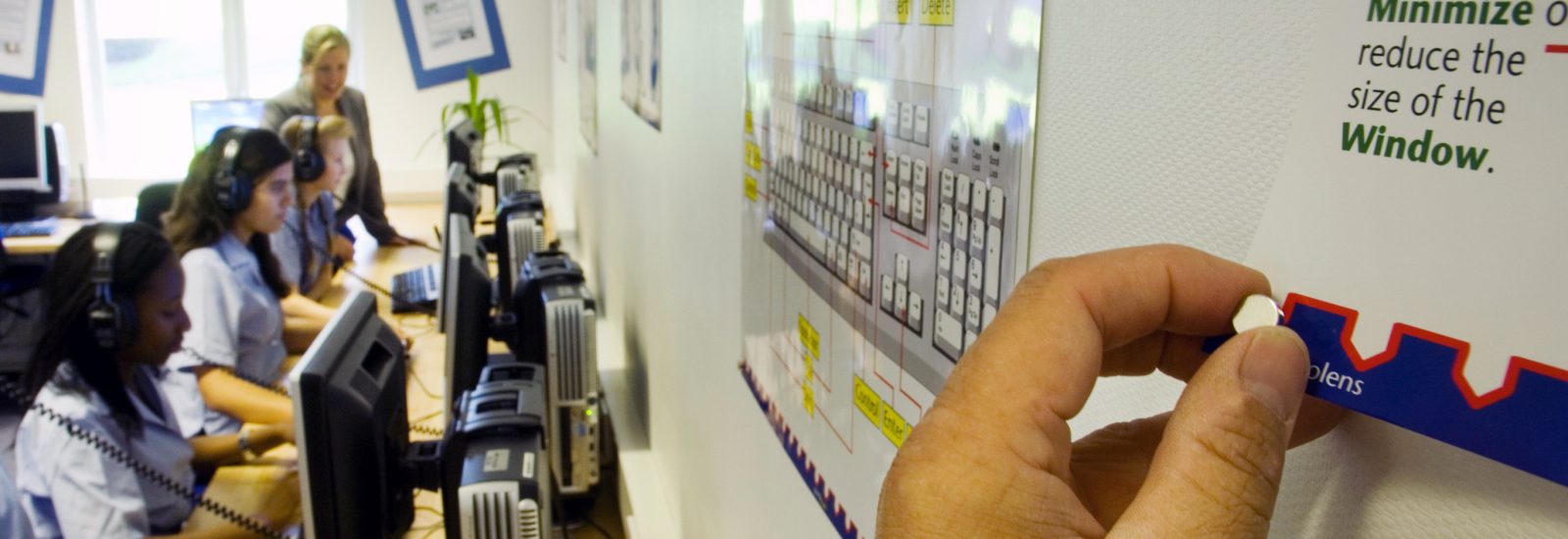Case Studies
Top of the Glass with Vitrulan Magnetic M39 wall covering
Gone are the days when schools could rely on a regular maintenance budget to repair the daily damage caused by a thousand wayward shoes and school bags.
Today, head teachers are faced with a maintenance task based on necessity. If the roof is leaking, it will need fixing. But it’s harder to justify budgeting for a regular annual or bi-annual repainting cycle when there are perhaps more pressing educational needs to attend to.
The result is one that most head teachers will tell you is not ideal: Peeling paint on window frames and shabby internal walls. This, though, is equally hard to justify when we are trying to instil in children a sense of pride in their school.
So how can schools overcome the problem of limited and irregular maintenance budgets while still ensuring their environment is one to be proud of?
One school in Kent believes it has found a solution that could save local authority schools thousands of pounds in maintenance costs – and could potentially save UK taxpayers millions of pounds.
Kent College Pembury is the first school in the UK to install a wall covering known across Europe as Glass Fabric. It comes in rolls like wallpaper, and is hung very much like wallpaper – but that is where the similarities end.
Firstly, it is made from glass. It is manufactured from woven glass thread to create a fabric which, when painted, is far stronger, more impact resistant, easier to clean and more hygienic than any other comparable wall covering in the world. It will hide cracks and prevent new cracks appearing, and, as glass does not burn, it is fire-retardant and meets all industry safety standards.
When it comes to economics, though, the glass wall covering is even more impressive. Its durability is such that it will last for 20 years, potentially without the need to touch it up with even a single coat of paint in that time.
This has already been proven in Europe, where the product has been used in schools, hotels, offices, homes and hospitals for years. Glass Fabrics are used extensively in Europe, particularly in areas of high footfall where there is a need for highly resilient wall finishes.
Mike Cooper, site manager at Kent College Pembury, said: “In our old buildings, we had salts coming through the walls, cracks and uneven surfaces. This glass wall covering completely gets rid of them. Nothing else would have done the job. And it will reduce our maintenance cycles significantly due to its long life.”
Mr Cooper initially installed the glass fabric in the school’s main entrance hall, but soon followed on with the computer rooms, RE room, staircases and sick bay area.
“Eventually I want to cover the whole school in it,” he said. “It has increased my costs in the short term, but it will pay back ten-fold very quickly. The walls can be wiped, even scrubbed, and because they are impervious when painted, there was no question that the hygiene qualities were perfect for the sick bay. I’d recommend it to anyone.”
The cleaning qualities of Glass Fabric mean that marks and spillages can be easily removed. And because glass is anti-static, the walls will not attract dust. Once coated, the walls become seamless, providing no spaces for bacteria to accumulate. Glass is also inorganic so, unlike damaged plaster and the cracks and grouting of ceramic tiles, it provides no breeding ground for germs.
Schools could therefore benefit from this textile glass wall covering in several ways.
But there’s more. Glass fabric is set to revolutionise classroom displays with a new wall covering called Magnet.
As with the standard Glass Fabric, Pembury has become the first school in the UK to install Magnet in a number of classrooms. Magnet shares all the qualities of the standard fabric, but a layer of steel powder infused into the backing allows any commercial magnet to stick to it.
The potential advantages of this for schools are enormous. Classroom displays can be changed as often as required without the creation of unsightly marks or surface damage from adhesive putty, sticky tape or drawing pins. This, alone, means that on-going classroom maintenance is significantly reduced. Entire walls can be covered with Magnet, providing an unlimited “canvas” and meaning expensive notice boards become a thing of the past.
So, despite the well-documented budget limitations faced by local authority schools today, there appears to be a solution. Mike Cooper certainly believes that schools could do a lot worse than question their traditional paint-on-plaster approach to walls and look towards Europe for a 21st Century alternative.

